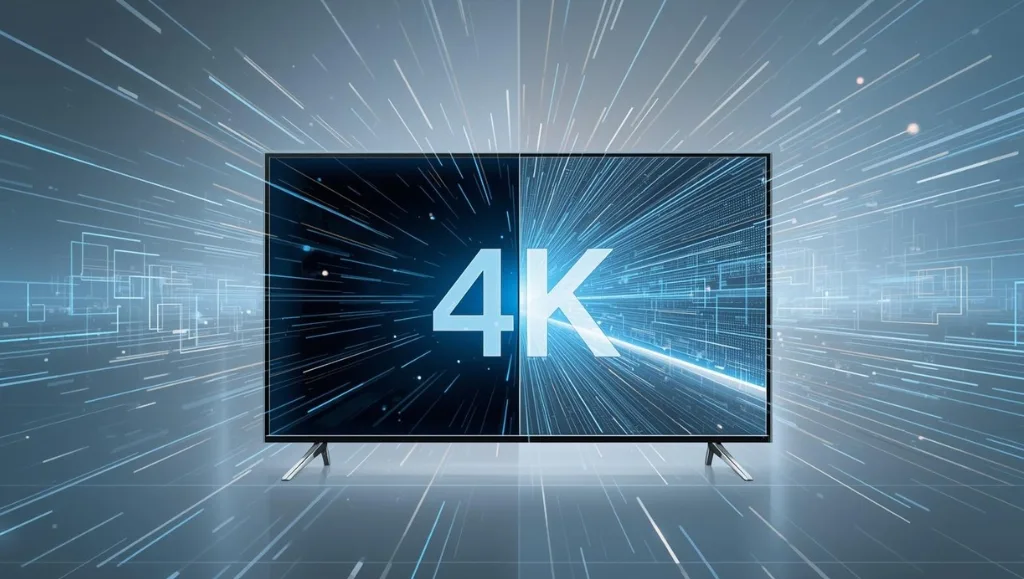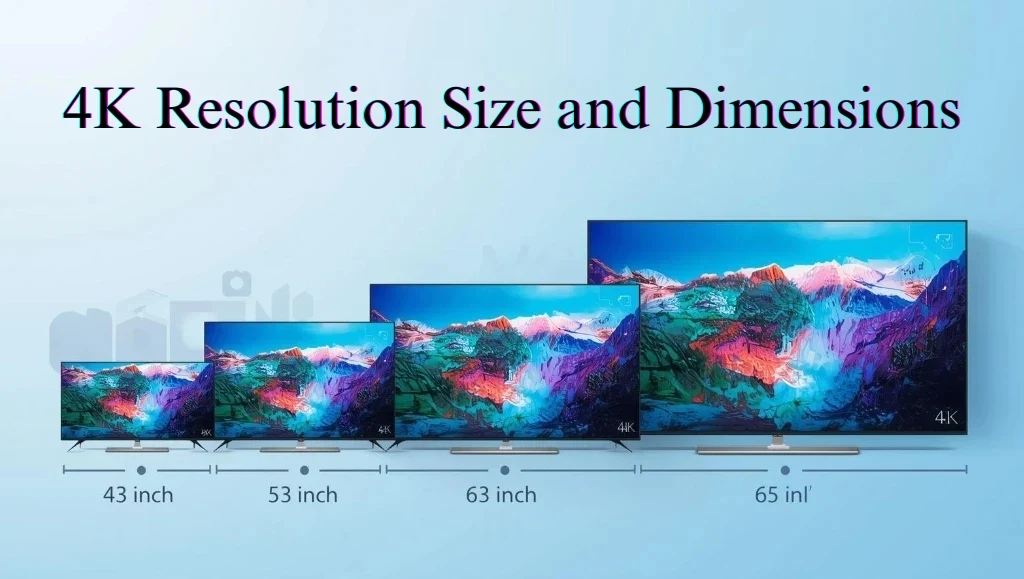People often ask, “What is 4K resolution?” because the term sounds technical but shows up everywhere, TVs, monitors, cameras, even smartphones. In 2025, 4K has become the standard for clear and sharp visuals, replacing Full HD as the baseline for most modern screens.
I still remember the first time I saw a movie in 4K, the details felt almost touchable. That’s why so many want to know what 4K really means. In this guide, we’ll explain it simply, with accurate and updated details, so you can finally understand whether 4K makes a real difference for you.
What is 4K Resolution?
4K resolution simply means a screen or video that shows around four thousand pixels across the width. Think of it as packing four Full HD (1080p) screens into one, so the picture looks sharper, brighter, and far more detailed.
The name “4K” comes from the horizontal pixel count. Instead of the old 1920 pixels in Full HD, 4K offers close to 4000 pixels across. That’s why manufacturers and the film industry use the word “4K” instead of “2160p.”
Key takeaway:
- 4K UHD (Ultra High Definition): 3840 × 2160 pixels → common in TVs and monitors.
- True 4K (DCI 4K): 4096 × 2160 pixels → used in cinema and professional film production.
I remember the first time I edited a 4K video for a client. The clarity felt almost unreal, and every small detail stood out, even things I had missed in Full HD. That experience showed me why people are curious about this resolution. Do you think your eyes would notice the same difference on your screen?
What Resolution is 4K in Pixels?
Most people hear “4K” and instantly think of sharper pictures, but the real meaning comes down to pixel count. A standard 4K display has 3840 × 2160 pixels, which equals more than 8 million tiny dots of color working together to create the image on your screen. That’s four times the detail of Full HD (1920 × 1080).
There are actually two versions of 4K used today:
- UHD (Ultra High Definition): the standard for TVs, monitors, and streaming platforms.
- DCI 4K: the digital cinema version used by filmmakers, with a slightly wider frame.
I remember the first time I compared the two side by side in a studio. The UHD looked perfect for home viewing, but the DCI 4K had that extra cinematic width you usually notice in theaters. It felt like watching through a wider window.
Here’s a simple breakdown:
| Format | Resolution (Pixels) | Aspect Ratio | Use Case |
| UHD (TV/Monitor) | 3840 × 2160 | 16:9 | TVs, monitors, streaming |
| DCI 4K (Cinema) | 4096 × 2160 | ~17:9 | Movie theaters, professional film work |
So, the next time someone asks “what resolution is 4K in pixels,” you’ll know it depends on whether they’re talking about a living room TV or the big screen at the cinema.
What is the Meaning of 4K Resolution?
The word “4K” comes from the horizontal pixel count, which is close to four thousand. A Full HD screen has 1920 pixels across, while 4K stretches that number to almost double. That extra width is what gives the sharper and more lifelike detail you notice on modern displays.
To make it simple:
- Full HD (1080p): 1920 × 1080 pixels → around 2 million pixels total.4K (UHD):
- 3840 × 2160 pixels → over 8 million pixels total.
That’s four times the pixel density. Imagine replacing one glass of water with four glasses filled to the top, that’s how much more “information” your screen holds with 4K.
I remember switching from a 1080p laptop screen to a 4K monitor for my editing work. Small details like jewelry textures or a hair strand, which looked blurred before, suddenly popped out with crystal clarity. It almost felt like cleaning a pair of dusty glasses and seeing the world fresh again. Have you ever felt that difference when moving from HD to 4K?
Visual idea: a side-by-side image that shows the same picture in Full HD and 4K. The Full HD version would look softer, while the 4K version reveals sharper edges and tiny details. This kind of comparison helps people immediately see the meaning of higher pixel density.
4K Resolution Size and Dimensions
A 4K display always carries the same resolution, 3840 × 2160 pixels, but the physical size of the screen can change a lot. You’ll see 4K stretched across TVs as small as 40 inches and as large as 85 inches or more. The most common options in the market are 43″, 55″, and 65″ screens.
Screen size matters because of pixel density. On a smaller TV, those 8 million pixels sit closer together, making the picture extra sharp. On a very large screen, the same resolution spreads out, which means you need to sit a little farther back to enjoy the same clarity. That’s why a 55-inch 4K TV feels perfect for most living rooms, it balances size and sharpness.
I once compared a 43-inch 4K TV with a 65-inch one in the same shop. Standing close to the bigger screen made me notice slight softness, but stepping back just a few feet gave the same crisp feeling. It’s like holding a photo in your hand versus hanging it on a wall—the image hasn’t changed, only how you experience it.
What is the 4K Monitor Resolution?
A 4K monitor usually runs at 3840 × 2160 pixels, the same resolution you find on 4K TVs. The difference is that monitors pack those pixels into smaller screen sizes, often 24 to 32 inches, which makes the picture look even sharper.
The benefits go beyond just sharp visuals. For everyday productivity, you can fit more windows and apps side by side without feeling cramped. For creative work like photo or video editing, details become easier to catch. And for gaming, the extra pixels make worlds feel more realistic, especially when paired with powerful graphics cards.
Refresh rate also plays a big role.
- Standard 4K monitors often start at 60Hz, good enough for browsing, office work, and casual gaming.
- Mid-range models offer 120Hz, which feels smoother and more responsive.
- High-end monitors now reach 144Hz or higher, built for serious gamers who want fluid motion and zero stutter.
What is 4K TV Resolution?
TV brands often market their models as “4K UHD” because they follow the Ultra High Definition format of 3840 × 2160 pixels. The “UHD” label helps buyers know it’s designed for home entertainment, not the wider cinema standard.
Streaming platforms have made 4K the new normal. Services like Netflix, Disney+, Amazon Prime, and YouTube all offer movies, shows, and videos in 4K. Some even provide “Ultra HD” tags so you know you’re watching the highest quality. With faster internet speeds in 2025, streaming 4K is smoother and more accessible than ever before.
The technology doesn’t stop at resolution. Features like HDR (High Dynamic Range) and Dolby Vision add brighter highlights, deeper blacks, and richer colors. Watching a sunset scene on a 4K HDR TV feels closer to real life, the orange glow, the soft shadows, everything looks more natural.
What is True 4K Resolution vs 4K UHD?
The phrase “True 4K” usually refers to the cinema standard, which measures 4096 × 2160 pixels. Movie theaters adopted this format to give films a slightly wider frame, closer to what directors imagine when shooting.
On the other hand, “4K UHD” is what most of us see at home. It measures 3840 × 2160 pixels and is used in TVs, monitors, and streaming platforms. The difference might look small on paper, just 256 pixels wider, but it changes the aspect ratio and how the picture fills the screen.
Key differences at a glance:
- True 4K (4096 × 2160): Cinema use, wider aspect ratio, professional film production.
- 4K UHD (3840 × 2160): Consumer use, 16:9 aspect ratio, TVs, monitors, streaming.
I once compared a film shown on a cinema projector in True 4K with the same movie streamed at home in UHD. The home version looked amazing, but the theater version had that extra width—you could see more of the scene on the sides. It felt like opening a bigger window into the story.
So the next time you hear someone say “true 4K,” ask yourself: are they talking about the big screen experience or the TV in your living room?
What is 4K Resolution in Video & Cameras?
The rise of 4K video has changed how we capture and watch moments. A 4K recording means each frame is made up of 3840 × 2160 pixels, giving sharper detail than Full HD. Many devices now let you record in different frame rates, 30fps, 60fps, or even 120fps, so motion looks smoother. Watching a 60fps 4K video feels almost lifelike, while 120fps is so fluid it’s like peeking through a window into reality.
Professional cameras such as DSLRs and mirrorless models use 4K to deliver crystal-clear footage for films, weddings, and content creation. I remember editing a wedding video shot in 4K—it captured tiny details like the sparkle of jewelry and the fabric’s texture, details that would have been lost in 1080p. Those little touches make videos more emotional and memorable.
Even smartphones have joined the 4K world. Today, most flagship phones, and even many mid-range ones, offer 4K video recording. That means you can film family trips, vlogs, or work projects with near-professional quality right from your pocket. Have you noticed how much sharper smartphone videos look compared to a few years ago? That’s the 4K difference.
4K vs Other Resolutions (1080p, 2K, 8K)
People often wonder how 4K stacks up against other resolutions. The difference becomes clear when you compare the pixel counts side by side.
|
Resolution |
Pixels (Width × Height) |
Total Pixels |
Common Use |
|
1080p (Full HD) |
1920 × 1080 |
~2 million |
Older TVs, budget monitors, streaming |
|
2K |
2048 × 1080 |
~2.2 million |
Some cinema screens, mid-range monitors |
|
4K UHD |
3840 × 2160 |
~8.3 million |
TVs, monitors, gaming, streaming |
|
True 4K (DCI) |
4096 × 2160 |
~8.8 million |
Cinema, professional film production |
|
8K UHD |
7680 × 4320 |
~33 million |
High-end TVs, future-proof displays |
The jump from 1080p to 4K is dramatic, you instantly notice sharper lines, richer colors, and more detail. Moving from 4K to 8K is less obvious unless you’re sitting close to a very large screen, like 75 inches or more.
So, which resolution works best for daily use in 2025? For most people, 4K UHD hits the sweet spot. It balances price, performance, and content availability. Streaming platforms, gaming consoles, and even smartphones now support 4K as the standard. While 8K sounds impressive, it’s still expensive, and very little content is made for it yet.
Final Thoughts
In 2025, 4K will have fully replaced Full HD as the everyday standard for TVs, monitors, smartphones, and cameras. It delivers sharper images, richer colors, and more lifelike details that make everything, from gaming to movie nights, feel more immersive.
While 8K is slowly emerging, it’s still expensive and not widely supported. For now, 4K remains the most practical and accessible choice, giving you the perfect balance of quality and cost.






